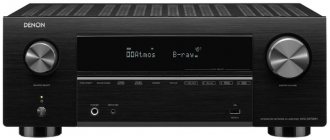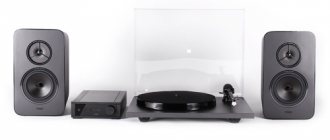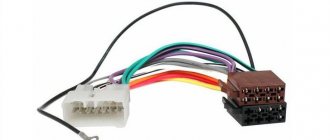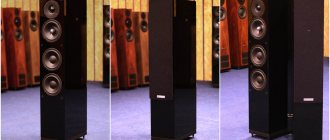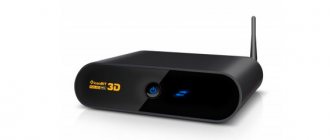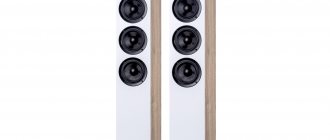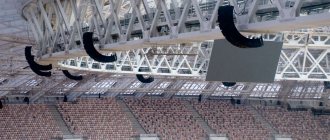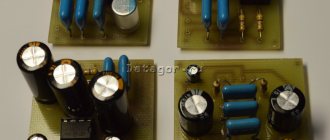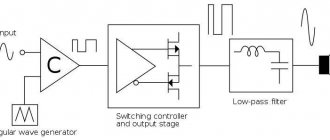Arslab: Affordable Russian Hi-End European class, article. Portal “www.hifinews.ru”
Russian engineering developments, European production culture and American investments are harmoniously embodied in Arslab brand acoustic systems. But the main thing is the idea that Hi-End loudspeakers can be accessible to a simple Russian music lover.
Save and read later -
Russian engineering developments, European production culture and American investments are harmoniously embodied in Arslab brand acoustic systems. But the main thing is the idea that Hi-End loudspeakers can be accessible to a simple Russian music lover.
Arslab now
The 2013 Arslab product line includes 12 models. It includes floor-standing and bookshelf speakers, center channel speakers and subwoofers. There are “basic” models. There are SE version products - with ribbon high-frequency drivers and a more advanced design to achieve better detail in sound. From the point of view of the results of strict acoustic measurements and subjective examination, Arslab acoustic systems can be classified as Hi-End solutions - these devices are ideal for creating high-level stereophonic and multi-channel systems.
Specifics
From the point of view of their “presentation”, Arslab products are aimed at Russian sound connoisseurs, who are especially scrupulous about the sound of speakers in the price segment up to 100 thousand rubles. That is why Wavecor was chosen as the speaker supplier - as one of the best European manufacturers of speakers in the High End segment today (in terms of price-quality ratio).
The production of Arslab acoustic cabinets (as well as the entire assembly and finishing process) is carried out on the basis of the Riga company World Audio Distribution.
Company's secret
How to create a decent Hi-End loudspeaker at an affordable price? The Arslab “concept” is a non-conveyor, “manual”, individual approach to each product using an advanced, automated production base. All components and finished products undergo mandatory testing at the “input” and “output”.
Corporate philosophy
Is it worth looking for “higher matters” by reinventing the wheel? High-quality components and the best engineers are the key to the right sound. Arslab engineers are moderate conservatives who use the principle of reasonable sufficiency in their work, where His Majesty Sound remains the main criterion.
The main principle is that the speaker system should not interfere with listening to MUSIC, and for this it must meet known technical requirements.
The name Arslab is a synergy of scientific and creative approaches (Ars from Latin - “art” and Lab - “laboratory”).
Top Model
Floor-standing speaker system Arslab Classic 3 SE Cost, RUB: 67,900
Technical characteristics of Arslab Classic 3 SE:
- Frequency bands: 3
- Speakers: ribbon tweeter, 1 x midrange 6″, 2 x bass 6″
- Housing type: bass reflex, rear panel port
- Impedance: 6 ohms
- Sensitivity: 87 dB
- Frequency range: 40 Hz – 25 kHz
- Dimensions: 200 x 1080 x 325 mm
- Weight: 25 kg.
People
General designer: Yuri Fomin, a famous Russian sound engineer.
Speaker Developer: Allan Isaksen, founder of Wavecor.
Technical Director: Viktor Lagarpov, who previously worked for many years as the chief engineer of the Radiotehnika plant.
Head of production: Maximilian Ranke (son of the founder of Ceratec).
Project coordinator: Artem Faermark, entrepreneur.
American business component
In 2008, the Arslab project was supported by an American partner, who decided to co-finance some of the developments and engage in their subsequent promotion. The American company World Audio Distribution was created. The company was headed by a talented manager, Yana Meidbray (formerly from St. Petersburg).
Milestones
2000 — Entrepreneur Artem Firemark and engineer Yuri Fomin joined forces to study the market and the features of speaker production.
2004-2009 — Creation of prototypes of Hi-End speakers in collaboration with Norman Hang, President and Lead Engineer of TB Speakers (Tang Band Ltd).
2008 — Birth of the Arslab brand; The project was supported by the American company World Audio Distribution.
2009 — Presentation of the Arslab Classic line at an exhibition in Las Vegas.
2009-2011 - Transfer of production to Europe (Riga), opening of the European division of World Audio Distibution in Latvia.
2012 - The production division of Arslab / World Audio Distibution was headed by Maximilian Ranke.
2013 - Modernization of production (closed cycle - all processes are concentrated in one place), release of a new line in 2013.
Russian distributor
Arslab presents acoustic systems on the Russian market.
Prepared based on materials from the portal “www.hifinews.ru”, February 2014
www.hifinews.ru
This article was read 8,951 times
The article is included in the sections:
Hi-Fi manufacturers. Stories and interviews
“Made with us” and on Yandex.Zen
He entered the musical environment closely (they built their own rehearsal base and recording studio Art Legion) and began to study the offers of domestic producers in the field of music. For example, we do not produce studio monitors (acoustics), sound cards, guitars, drums, but our microphones and guitar acoustics are appreciated in our country and abroad. I want to talk about such companies.
© www.oktavatula.ru
Yerasov https://www.yerasov.ru
A company engaged in the production of guitar acoustics: amplifiers, speakers, mixers, guitar effects, preamps, acoustics, amplifiers.
© www.oktavatula.ru
The music corporation "ERASOV" was founded in 1988 in Penza by engineer and musician Alexander Erasov, who is currently its owner and president.
In recent years, modern technologies in the field of electronic instrumentation have been mastered - surface mounting of microelements (SMD) on printed circuit boards, powder painting in an electrostatic field, computer modeling, etc. A testing laboratory has been built, equipped with the most modern measuring equipment, allowing to bring product quality to European standards and receive appropriate certificates. In 2003, the export of part of the products to Western European countries began. Currently, the company is the largest manufacturer of musical equipment in Russia with about 200 employees, a production area of about 1500 m2 and sales offices in more than 70 cities in Russia.
Microphone production plant "Octava" https://www.oktavatula.ru
As can be seen from the website, the plant is located in Tula and employs more than 150 employees.
OJSC Oktava is the leader in Russia in the production of studio microphones, telephone and microphone capsules, headsets, and hearing aids. Tula-made products are used in recording studios in England and the USA, Germany and distant Australia.
Frankfurt © oktavatula.ru
In recent years, the company has received a number of awards. The plant is a laureate of the “One Hundred Best Products of Russia” competition, laureate of the All-Russian Award “For the Best Domestic Innovation” in the “Studio Equipment” category. The company was awarded the “Grand Prix” of the international program “Partnership for Progress”.
Octave condenser microphones have been successfully used by many musicians around the world, some of the most famous names include Sting, Sheryl Crow, Edwyn Collins, Mike Oldfield, Roger Taylor, Mick Taylor, Radiohead, Iron Maiden and many others.
Digilab - https://www.digilab.rf
Moscow factory of concert and studio equipment. According to my personal estimate, it has about 30 jobs.
It produces such equipment as a monitor console, monitor controller, preamplifiers, analog-to-digital converters, sound level meters, network distributors, etc.
© www.oktavatula.ru
https://www.noema.ru/
Novosibirsk company specializing in the production of acoustic systems. Speakers, amplifiers, speakers. By the way, Erasov, as far as I know, along with imported speakers in his acoustics, also uses Noem speakers. According to my personal estimate, the number of plant employees is about 200 people.
© www.oktavatula.ru
Tract Company - https://tract.digispot.ru
St. Petersburg company specializing in the supply of solutions for digital broadcasting, as well as for recording studios. About 50% of Russian radio stations use Traktov devices as part of their equipment. According to my personal estimates, the number of employees at the plant is about 80. It also produces studio furniture.
© www.oktavatula.ru
“Russian High End”: from now on – annually
We continue to publish reports from the Russian Hi-End exhibition. Next up is the year 1997 and one of the most interesting and eventful exhibitions in the entire history of the RHE.
photo: Mikhail Grushin
High End is a sound recording/reproduction system, not a single link of which can be neglected and not a single link of which can be “extended” from the system as a whole. R.G.Varlamov
High End is when it gives you goosebumps. V.A.Starodubtsev
For the third time, leading domestic audio equipment manufacturers are coming together to show the world their achievements. This time - under the roof of the Moscow Technical University of Communications and Informatics. It was the MTUSI Acoustic Center that became a sponsor and one of the organizers of the exhibition “Russian High End '97”, which took place from April 5 to April 13 in Moscow.
Sponsorship made it possible to halve the cost of participation in the exhibition and make entry free for visitors. The organizers were also the Russian section of the International Society of Acoustic Engineers (AES-Russian), Moscow and Natural with information support from the magazines “Salon AV”, “Radio” and the radio station “Prestige”.
Compared to last year (see “AV Salon” No. 3 for 1996), the number of participants has increased significantly, reaching thirty. The geography of High End distribution has remained almost unchanged - Moscow, St. Petersburg, Kharkov, Taganrog, Tver, Khabarovsk and Podolsk were represented.
The first two days the entrance was open to specialists and representatives of the press, which gave journalists the opportunity to slowly get acquainted with the exhibits, and the participants to communicate with each other. A warm, friendly atmosphere reigned in the hall: it was noticeable that it was not competitors who gathered here, but like-minded people. This was especially felt at scientific and technical seminars held in the assembly hall of the University: everyone who could leave pressing matters at their stand tried to listen and take an active part in the discussion. What was pleasantly surprising was the understanding and genuine interest that students, who made up a fair portion of the visitors, showed in lamp technology. Is the younger generation choosing High End?
By the way, the abstracts of the speeches made at the seminars were published in advance as a separate brochure and were given free of charge to everyone. In general, the organization of the exhibition was excellent: each exhibitor was allocated not only a separate box, but also time in the listening room, where they could listen to samples and ask questions to their creators. The organizing committee answered any questions, incl. and by telephone; The schedule of auditions and presentations at the workshop was well thought out. Not to mention the fact that two banquets were organized - one in honor of the opening, the other - farewell, on the last day of work. After the end of the exhibition, it was decided to hold it annually within the walls of MTUCI, and more than forty companies have already submitted applications to participate in it next year.
An exciting moment. The green (“signature” color of the exhibition) ribbon is cut by MTUCI Rector V.V. Shahgildyan.
The organizer of “Russian High End '97” is the head of the MTUSI acoustic center D.G. Svoboda shows the exhibition to distinguished guests. Among them is the technical director of the Federal Television and Radio Broadcasting Service V.G. Makoveev and the head of the scientific and technical department of the State Committee of the Russian Federation for Communications and Informatics S.L. Mishenkov.
Opening reception. The first toast, as usual, is to success and longevity.
Listening room equipped by the Acoustic Center. Despite the tight preparation time, the specialists managed to turn the classroom into a hall with optimal acoustic parameters. On the right is part of the reference system provided by the Nota Plus salon: Cary Audio Design CAD 300B amplifier and Apertura Athena speakers.
Saratov products are demonstrated by L. Peretyaka. Reflector has been producing radio tubes since 1953. Now its production program includes about 60 types of electric vacuum devices, and more than 15 of them are sold abroad. Firms such as Sonic Frontiers and Manley successfully use Saratov products because their quality is ensured by defense technology. After a sharp drop in demand for lamps for television and radio receivers, the company places its main emphasis on audiophile products - 300V, EL34G+, 5881, 6922, etc. This summer, a whole line of powerful output tetrodes will appear in the product range - KT66, 6550 and KT88. The plant plans to soon open its representative office in Moscow. By the way, “Sovtek” and “Reflector” are the same thing. Sovtek does not actually produce anything, but only puts its trademark on for selling Saratov products abroad. I was especially pleased that the lamps could not only be seen, but also purchased at quite reasonable prices. It is worth noting their really high quality: the EL34G+ purchased by the author sounded excellent and had a spread of parameters of no more than 1%.
At our magazine's stand you could get any advice.
“We will make rusty Russian iron sound!” - “the genius of cheap amplifiers” Igor Gubin demonstrates a series of tube amplifiers with power from 2.5 to 100 W per channel. The Laboratory currently produces about 20 amplifier models, including telephone and linear amplifiers, as well as tube network stabilizers/filters with a power of up to 0.5 kW. An amplifier powered by the legendary 300V is being prepared for serial production. The goal of the designer is “to introduce the broad masses of Russian audiophiles to real sound, to infect them with the tube virus.”
Vladimir Starodubtsev's amplifiers are two-stroke Musicmagic and single-stroke Mustang on 6С33С. Their creation was preceded by long and painstaking work - the choice of circuit design, experiments with feedback depth, listening to various types of radio components and wires. Currently, two versions of Mustangs are produced - with and without an interstage separating capacitor. Listening at the exhibition showed that they sound completely different. I recently started designing acoustic systems designed to work with single-ended tubes, because Increasing the sensitivity of the speakers by 3 dB turned out to be much easier than doubling the amplifier power. Currently, “3B” produces several types of ARSound speakers with Kevlar diffusers and a sensitivity of 92 - 95 dB/W/m.
St. Petersburg, spun off from IRPA named after. A. S. Popova has extensive experience in designing acoustic systems. After many years of searching for the best material for making diffusers, its experts settled on aluminum honeycombs - the same ones used in aircraft and rocket production. The flat honeycomb diffuser has amazing rigidity (which the author had the opportunity to verify personally, unsuccessfully trying to crumple a small piece of material) and lightness. Acoustic systems are manufactured to individual orders, and some of them (“Rus”) are used in the unique interiors of the Tauride and Mariinsky palaces. Now the company's catalog includes four speaker models with power from 15 to 200 W. The products of “Sound” were highly appreciated by T.F. Faberge.
“Hurray, Victoria is behind us!” The only transistor exhibits are an equalizer, a spectrum analyzer and a reel-to-reel tape recorder from the Taganrog Scientific and Technical Center "Kolvir". In front of this technique, visitors froze in amazement because of the stunning disco sound and astronomical price ($10,000 per set).
The creations of Alexander Gaidarov are acoustic systems with a circular radiation pattern. Behind them are years of work and our own concept of sound reproduction. The speakers are carefully calculated and hand-made using American Polk Audio drivers.
Surround sound systems of Yantar JSC and Montazhnik LLP (Podolsk). Two diametrically opposed approaches to sound reproduction.
The new design of the Valankon amplifiers is a set of UP 01 and UM 01. The principles, however, remain the same: a 6P45S output stage with a large pulse current; industrially manufactured steel chassis; large overall power of transformers (1.5 kW - power, 1 kW - output); volumetric installation with large cross-section wires.
Wood and polished metal from Past Audio. The company's catalog includes more than 20 models of single-cycle, push-pull, telephone, linear, correction, passive amplifiers and network filters. When asked by the correspondent to talk about his work, chief designer Anatoly Devichensky answered succinctly: “We search, we try, we implement, we don’t stop there.”
Natural: there is a surprise for every exhibition. This time it's a full SA-2 tube amplifier (in the middle) with a translucent front panel. The triode transformer SA-1 (above), first introduced last year, has been significantly upgraded. Next up is a revolution in the design of acoustic systems: stone and ceramic materials will be used in the design of “pulsating spheres”. Musicians of the Moscow Academic Symphony Orchestra under the direction of Pavel Kogan are involved in working on new models.
This is not a “home cinema”, but a home doctor. The Russian-German company Jump Electrotechnic GMBH demonstrates resonant acoustic systems, which, as studies have shown, have an extremely beneficial effect on the human body - reduce fatigue, nervous tension, stimulate brain function, etc. They just sound, frankly, a little specific.
T-34 MK II and "Narodny" - amplifiers from SPB Sound.
Guest from abroad. The amplifier from the Kharkov company George Ohm has nothing to hide.
PS We were not able to photograph the Tver Soundsaver stands, which arrived literally the day before the exhibition closed. They use a double principle of combating vibrations - isolating unwanted vibrations at the tip of the core support (spike) and damping them in the rubber liner. The frame of the racks is welded with brass from a steel profile, the shelves are carved from marble. In the center of the rack, a hollow steel cylinder rests on spikes, filled with sand from the inside. A pair of these designs can be purchased for as little as $300.
Alexander Utekhin, who represented the St. Petersburg company High End Master, was also not included in the shot. But we will remember his motto: “Keep your End High!”
share
Tags: Chronology of Russian High-End
Village Hi-End business. Acoustic thought should not stand still. Part 1.
Most of the acoustics sold in Russia, in the Hi-FI, Hi-END categories, belong to European brands. Almost all European acoustics manufacturers are located in populated areas with a population of several thousand people. In Russian terminology, these are villages.
And all over the world the situation is little different. These are small settlements on the periphery. But there are also regional centers.
For example, let’s take the popular and actively promoted acoustic system company “DALI” in Russia. Another company could have been chosen - for others everything is approximately the same.
“DALI” is located in Denmark in the village of Nørager. The first thing Google brings up about Nørager is that there was a fire.
“The fire was caused by agricultural tools catching fire in a shed filled with straw.”
Satellite view of Nørager. The scale is given. In 3 minutes you can walk through it.
Google reports that 1,040 people live there. There are no planes flying there and no trains going there. And if by chance a lost tourist bus stops by, this will dramatically increase sales in the only grocery store. Although, where do tourists come from there, even theoretically?
There is no doubt that the best minds in the village are involved in the creation of acoustic systems. Of course, with the exception of that part of the intellectuals who are engaged in agricultural work.
It should be understood that the village, unlike megacities, lives its own way of life, and other issues become important. How many tons of clover from each laying hen will be poured into the incubators after threshing the plowed land? Mowing in the morning, milking in the evening... And then the cherry tree came up!
What if it rains during drying? Is there a fire in a barn with straw?
It is worth noting that the “DALI” acoustics, compared to the general background of what is sold in Hi-Fi stores, are quite decent. Yes, they haven’t succeeded in everything yet. But “DALI” declares its desire to make acoustics that will convey the sound of the original as accurately as possible. For now, it’s true that different acoustic models themselves sound different. But this just means that there is room for improvement.
Acoustic thought does not stand still and moves forward. And there are no obstacles to this. After all, the fire in the straw barn was successfully extinguished.
Village kids follow all fashionable trends in the field of recording very closely.
The head of DALI tracked what the compression level was in the middle of the last century.
In my humble opinion, it was still better to pay attention not to what compression was like half a century ago, but to the problems of the present:
In an effort to stand out from the crowd of similar manufacturers, “DALI” developed a signature color for their acoustic diffusers.
We don’t know who came up with such a wonderful color, and what guided him in doing so. But a certain incident happened. There are people, myself included, who have noticed the amazing similarities.
It is admirable how accurately the designers managed to convey even the texture. It is unknown what meaning the manufacturer put into this. Most likely, the choice of color and texture was made based on the phrase attributed to Karl Max, “Existence determines consciousness.” Although, it is not known for certain whether Karl Marx said this phrase or its author was someone else.
Perhaps this is their national joke, something we don’t understand . And they joke in such a peculiar way.
The Danes are generally special people. Queen of Denmark - Margrethe Alexandrina Thorhildur Ingri. She has many medals and orders.
| Margrethe Alexandrina Thorhildur Ingri |
|
It is considered normal to gather children to demonstrate the dismemberment of a lion. And they launched a live broadcast of this process in the media:
Denmark, lion dismemberment
There is a children's program on Danish television called Ultra smider tøjet ("Shedding his clothes"). Educational program. Children carefully examine the labia of women. They try to guess the length of a man's penis. Pubic hair is studied. The picture shows all the anatomical details in close-up:
Danish TV show characters undress and show their genitals to children.
That is, the original design of the diffusers is easily combined with the general specificity of the Danes’ perception of the world.
“DALI” has a huge head start in terms of sales, since the brand was originally created as a private label (private label) sales network.
For those who don’t know what private labels are, these are the types of Russian private labels “Red Price”, Perekrestok”, “Homeclub”, “Lenta”. The main thing here is that the product automatically gets on the counter and is automatically sold according to how it is on that counter.
And anyone can make the goods themselves. Usually production is thrown to the periphery, or the Chinese are engaged in production. In the modern world there is no problem to do. The problem is completely different - how to sell.
And of course, for this it is important to minimize the price, and production is located where it is possible to pay workers as little as possible. In the case of DALI, they took the most uncompromising route - it is hardly possible to locate production in a village with a smaller population. Physically, there will be no one to saw the boxes and screw in the screws, since usually about 70% of the village population are pensioners and children.
There is a well-known phrase - that you can take a girl out of the village. And such experience exists. “DALI” was partially taken from the village to one of the technological centers of China. But in this case the example is not entirely correct.
Initially, the goal was not to make it better, but to make it cheaper. In China, they produce “economy class” lightweight and cheaper versions of acoustics. At the same time, this is how the Chinese make them - they sell spare parts on Aliexpress almost by weight. Not expensive:
Link to them in China
Almost all acoustics with a retail price up to approximately $1500 are made in China.
At first glance, it seems that they are completely greedy in their village. Well, why don’t they make acoustics for $300.
Moreover, in production technology, acoustics are boxes with speakers. But the fact is that the village workers themselves get about 15-20% of the retail price. The level of wages in the countryside is, of course, much lower than in the cities, but producing acoustics at an adequate price, with such a level of trade markup, is problematic even in the countryside.
If we take Samsung or Xiaomi, they interact almost directly with customers. They have huge volumes, and the markup is microscopic. In Hi-Fi and Hi-End they make money on piece sales with a huge markup.
To understand the level of the markup, the car's gearbox is shown below. Its workload is tens of tons. The cost in the total price of the car is about 5%. Look at the level of technology. This cannot be done in the village.
What do you need to get a finished product car? Add the car itself to this box! And it contains several tens of thousands of components. The wires alone weigh about 20 kg! The total length is tens of kilometers !
And here is the level of complexity of the tomograph.
Tomograph without plastic lining.
This is what the speaker looks like.
Its workload is several kilograms. The design is, to put it mildly, simple. It is quite within the capabilities of village workers.
What do you need to get a finished product acoustic system? Take several speakers and insert them into an MDF box . You will also need a couple of meters of wire and aluminum foil rolled into a tube.
A natural question arises, where is Zin’s money? Especially when the acoustics are sold at a price comparable to the cost of the car.
The bulk of the money is eaten up by multiple intermediaries. Next comes the rental of empty hi-fi salons. Salaries of bored salespeople. And a separate song - advertising.
The already mentioned “DALI” paid the top curly-haired blogger Varlamov for two advertising articles. And they even took him to their village. Varlamov seems to have gotten a little sick from the situation. But the money was paid, he wrote the articles.
If the public reacted relatively evenly to his first article. The second time, when he offered to buy acoustics from the village, for several hundred thousand rubles... The following post turned out to be the most popular... and it still hangs at the top!
Varlamov’s advertising articles cost a lot of money. But even people far from the world of advertising understand that the effectiveness was not very good. Perhaps it would be better for the good of the cause to immediately flush this entire advertising budget down the toilet.
But this is nothing compared to the fact that entire work teams come to work with the sole purpose of writing advertising materials for Hi-Fi. From time to time, they are centrally loaded onto buses and transported to villages and regional centers. And this is not a form of speech - planes do not fly to villages and trains do not go there.
After which they begin to broadcast streams of delight to the sponsors. Everything is like about the dead - either good or nothing. Since there is nothing but delight, and there is no content, additional and very serious costs are required to distribute these materials.
Audio muzzles, as they are commonly called in the audio community, are a unique genre in nature. All media, all over the world, always work this way - they produce content that is of interest to the audience. Advertising, sometimes hidden, is broadcast to this audience. This is what they live by.
Audio files have simplified the process to a business model of catalogs thrown in batches into mailboxes. No content is needed - money is taken immediately for distributing advertising materials.
As a result, this entire “banquet” is paid for by rare buyers of Hi-Fi equipment.
What exactly to sell in this business model is absolutely irrelevant..
Everyone at this celebration of life is busy with their own business and earns in their own way. Someone is making articles about magic wires... “A cable for a million rubles can transform your system and turn on the air “pump.” Others calculate how many times an advertising banner needs to be shown in order for a sale to occur.
Villages also do not waste time and compete with each other. The frequency response has already been measured in Villaribo, and distortion is still being measured in Villabaggio. But it's not easy for them. Since in the village of Villaribo the result was 0.001%. They have a larger anechoic chamber. They go out a few meters into the field, and there it is, an ideal anechoic chamber several kilometers in size.
In principle, there is nothing to reflect the sound, because there is nothing around for several kilometers. Only penguins and astronauts have a larger anechoic chamber.
It is only important that the tractor does not plow close at this time. Otherwise it will be like in the song.. “What’s on your mind, an amplifier and a monitor? You better listen to how my diesel engine roars. The tractor will sing plows and woogies to us, against the backdrop of a rural panorama.”
Initially, you should not have much hope that when you enter a Hi-Fi salon you will be inspired by the sound quality that you will hear there..
On average, the quality will arrive within the framework of compliance with the international AUV ( Applicability Use Village ) specification standard. Which can be loosely translated as - will do for rural areas.
For this reason, calls to buy a record player should be treated with understanding. A list of positions has been drawn up, advertising has been paid for, equipment from Villaribo and Villabagio has already been delivered. The sales plan has been approved for several years ahead. Everything has already been decided - buy what they give.
They have no time for you, their cherry has sprouted. The question, why the hell are gramophone records needed in the era of terabyte disks and pocket processors with counting speeds thousands of times faster than realtime, is of no interest to anyone. They have been selling and selling even more for decades.
Continuation : Village Hi-Fi-End business. Part 2 .
Beginning of a series of articles : Hi-Fi is dead, but we are not yet. Part 1
Reader Poll
Are you satisfied with the equipment sold in Hi-Fi salons? (quality, price)
If you find an error, please select a piece of text and press Ctrl+Enter.

